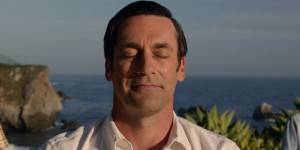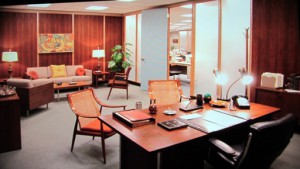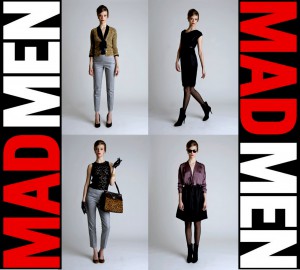Style, Structuring Conceits, and the Paratexts of Mad Men

Fig. 1 — Mad Men from first …

Fig. 2 — …to last.
Post by Piers Britton, University of Redlands
In a manner befitting a series that flourished on its reputation for visual elegance, the finale of Mad Men, “Person to Person,” rewarded attentive viewers with an ending that subtly called upon the pilot episode. The opening of “Smoke Gets in Your Eyes” was a gentle right-to-left tracking shot across a crowded bar, which ends with a dolly-in to the back of Don Draper’s head (Fig. 1). The close of “Person to Person” also begins with a right-to-left tracking shot, across the cliff-top lawns of what is supposed to be the Esalen Institute, and in the final moments there is again a dolly-in – but this time to a frontal close-up of the enigmatically smiling Don, eyes closed (Fig. 2). It is tempting to read the shift from rear to front view as a reification of narrative closure: in “Smoke Gets in Your Eyes” (and in the opening titles of every subsequent episode) the over-the-shoulder shot of Don draws us into the world of Mad Men, into what lies before us and before him. The frontal shot conversely seems to evoke finality; it acts as a caesura, sealing off behind Don all that we have witnessed in the last eight years, compartmentalizing the series as something done and complete.
If such a visual metaphor was intended, it was perhaps the only way of drawing a clear line under Mad Men, a series that was never going to lend itself stylistically to dramatic resolution in the same way as, say, its AMC sibling Breaking Bad. Mad Men begins and ends with Don Draper, and as the frequently reiterated over-the-shoulder shot from the pilot suggests, his experiences willy-nilly offer the dominant point of view for the audience. Yet Mad Men is not Don’s story: it has always been a ensemble piece, and a resolutely untidy one at that. Some characters have abruptly disappeared (Sal Romano, Paul Kinsey), some others have wandered in and out of focus (Ken Cosgrove, Trudy Campbell, Bert Cooper), while six protagonists apart from Don (Peggy Olson, Pete Campbell, Betty and Sally Draper, Roger Sterling and Joan Holloway) have remained in, or somewhere near, the spotlight throughout. No recurring character had an “arc” in the conventionally understood sense of the word, for Mad Men has remained fundamentally skeptical about its characters’ capacity to grow and change according to some Save The Cat-type screenwriting logic. It is unsurprising, then, that the final few episodes seemed to be casting more lines than they reeled in, with Peggy and Roger embarking on new romantic relationships while Pete and Joan embrace or create new business opportunities. Given what we have seen of these characters over seven seasons, there is no good reason to envisage any of these new departures as “happily-ever-after” scenarios. Indeed, the only real certitude offered by the finale is that of Betty’s impending death from lung cancer. Even the closure of Don’s narrative is provisional: though the narrative does not make it explicit, that final smile seemed to many commentators to suggest that the series ends exactly as Don is dreaming up the famous “Hilltop” Coca-Cola ad that served, appropriately, as Mad Men’s coda. (Showrunner Matthew Weiner has since confirmed this.) Earlier in the episode, Stan Rizzo pointed out that Don’s going AWOL is a recurring pattern, while Peggy, in her person-to-person call with Don, underscored the fact that he could easily return to work at McCann. With these cues in mind, the road trip ending with his Esalen revelation should surely be read not as culminating catharsis but as yet another interlude.

Fig. 3 — Spaces of Madernity
So, if dramatic closure of character storylines was not on the cards, what exactly is it that became complete with the finale of Mad Men? Or, to put it another way, how can we understand the series’ structure in retrospect? One obvious way of answering this—perhaps the only incontrovertible way—is to note that the series’ story spans almost exactly a decade: starting in March 1960, the Mad Men narrative apparently ends in late October or November 1970. Mad Men in toto is thus an encapsulation of the Sixties, a fact that is likely to be remembered long after its narrative twists, recapitulations, and volte faces have faded from the memory of all but the most devoted fans. The “Sixties-ness” of Mad Men is in part marked by historical events that variously affect the protagonists’ work, emotional life, and attitudes, from the 1960 presidential election to the 1970 Newsweek gender discrimination lawsuit. More obviously, and from certain vantage points more potently, Mad Men is defined by the 1960s in terms of visual style. Quite apart from offering a much publicized parade of vintage fashions, period props and stylish environments, the show visually evokes late Fifties and Sixties films in its cinematography, and especially its lighting. Evocation is clearly not the same thing as reconstruction, pace detractors who have raised complaints about narrowness of focus or lack of “authenticity.” A good deal of commentary—some neutral and some adverse—has focused on the fact that Mad Men is a show about the Sixties created by a man who is, as Robert Lloyd succinctly put it, “too young to really remember them.” In itself this claim isn’t particularly useful. It would be hard to mistake any scene from Mad Men, with its wonderfully stately, stylized dialogue, as an attempt to recreate Sixties mass-media vernacular, however sumptuously persuasive the visual recreation of the period might seem. Indeed, the claim that Weiner is “too young” has curiosity value precisely because he was born in the Sixties: observing that Julian Fellowes is too young to recall the era of Downton Abbey would hardly have the same piquancy.

Fig. 4 — Symptoms of Madmenalaria
That said, if the show did not in any absolute sense espouse period authenticity it seems hard to overstate its Sixties-philiac tendencies. Visual pleasure in Sixties styling looms large, as a key part of Mad Men’s identity, not just in the “raw” text of the episodes but also in its astonishingly consistent, cumulatively powerful paratexts, most notably the documentary videos on the Mad Men section of AMC’s website. “Making of Mad Men” and later “Inside… Mad Men” featurettes have appeared on the site throughout the series run, increasingly focusing on the micro-narrative of each episode and the characters’ motivations, as explicated by the actors portraying them, and by Matthew Weiner. After four seasons the “Fashion File” feature that accompanied each episode was replaced by a second regular video, “Fashion and Style,” based around interviews with the costume designer and property master or set decorator. If the “Inside …” videos speak to Mad Men’s “depth,” which is to say the ways in which it can be recognized as quality TV, worthy of the multiple awards and plaudits it has won, the “Fashion and Style” videos correspondingly speak to the importance of “surface.” Mad Men has reworked and mobilized the so-called “mid-century modern” to generate not just media buzz but an extraordinarily influential brand. The series’ fetishizing of Sixties clothes, hairstyles, accessories, cars and interior decoration has spawned an array of imitative or broadly competitive programming in the US and overseas, from Magic City via The Hour and Masters of Sex to Vegas and Aquarius. Mad Men has made a somewhat improbable style guru of its costume designer, Janie Bryant, it has begotten clothing lines for both men and women at Banana Republic and Brooks Brothers, and more broadly it has produced a fad that one commentator drily named “Madmenalaria.”
As Mad Men coalesced into a whole in the only way that television series can, by ending, then in so doing it underscored the fact that like Don Draper it has always embodied—even depended on—a duality. Other film and television texts may have de facto thrived on a tension between the espousal of emotional truthfulness on one hand and preoccupation with “superficial” visual pleasures on the other, but Mad Men is perhaps the first in which this dichotomy has been so smoothly reconciled into a branding strategy. The final ambivalent meeting of inner worlds at Esalen—with Don either/both finding spiritual peace and/or dreaming up the basis for a career-defining ad—could not more perfectly have encapsulated the obverse and reverse of the Mad Men coin.


